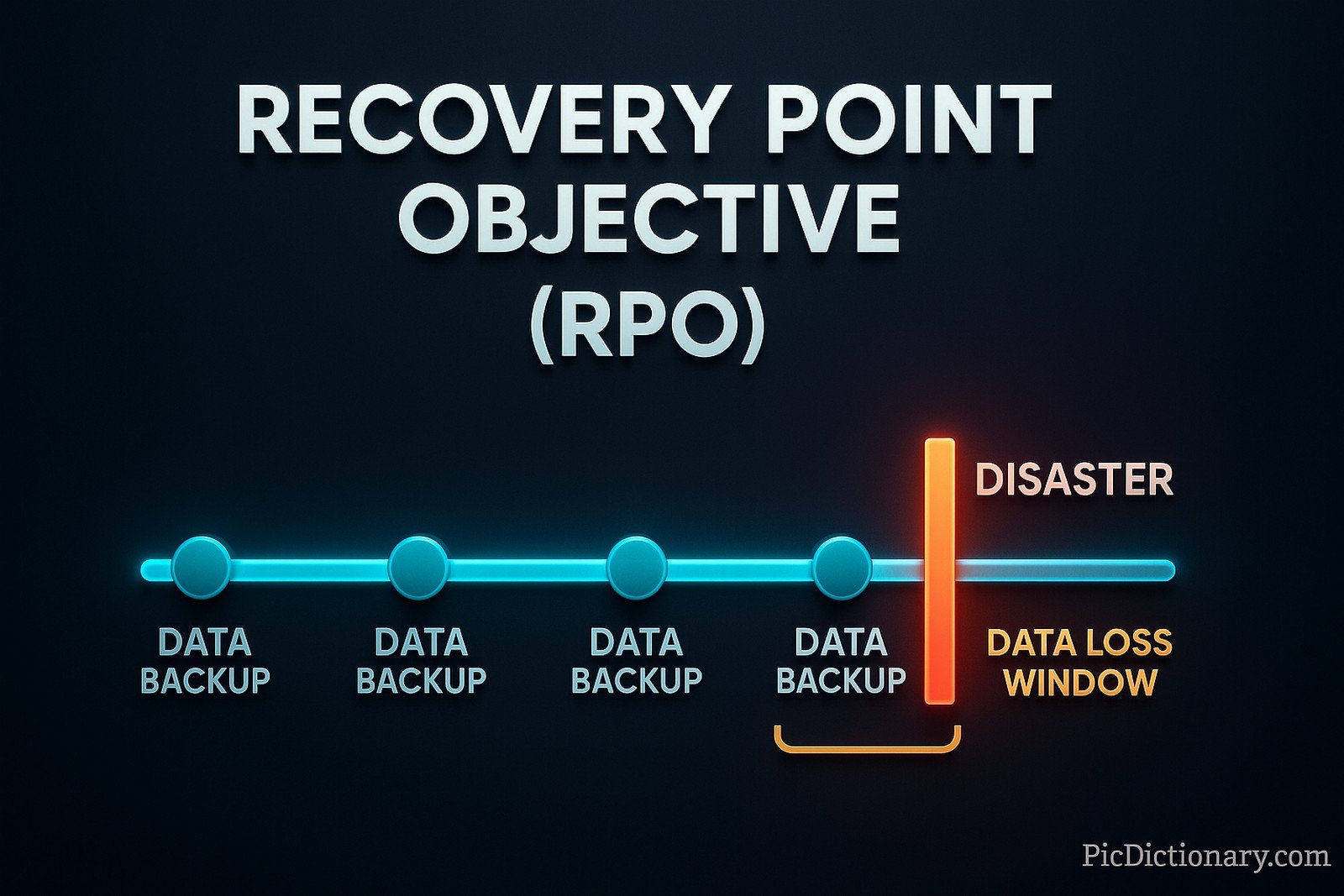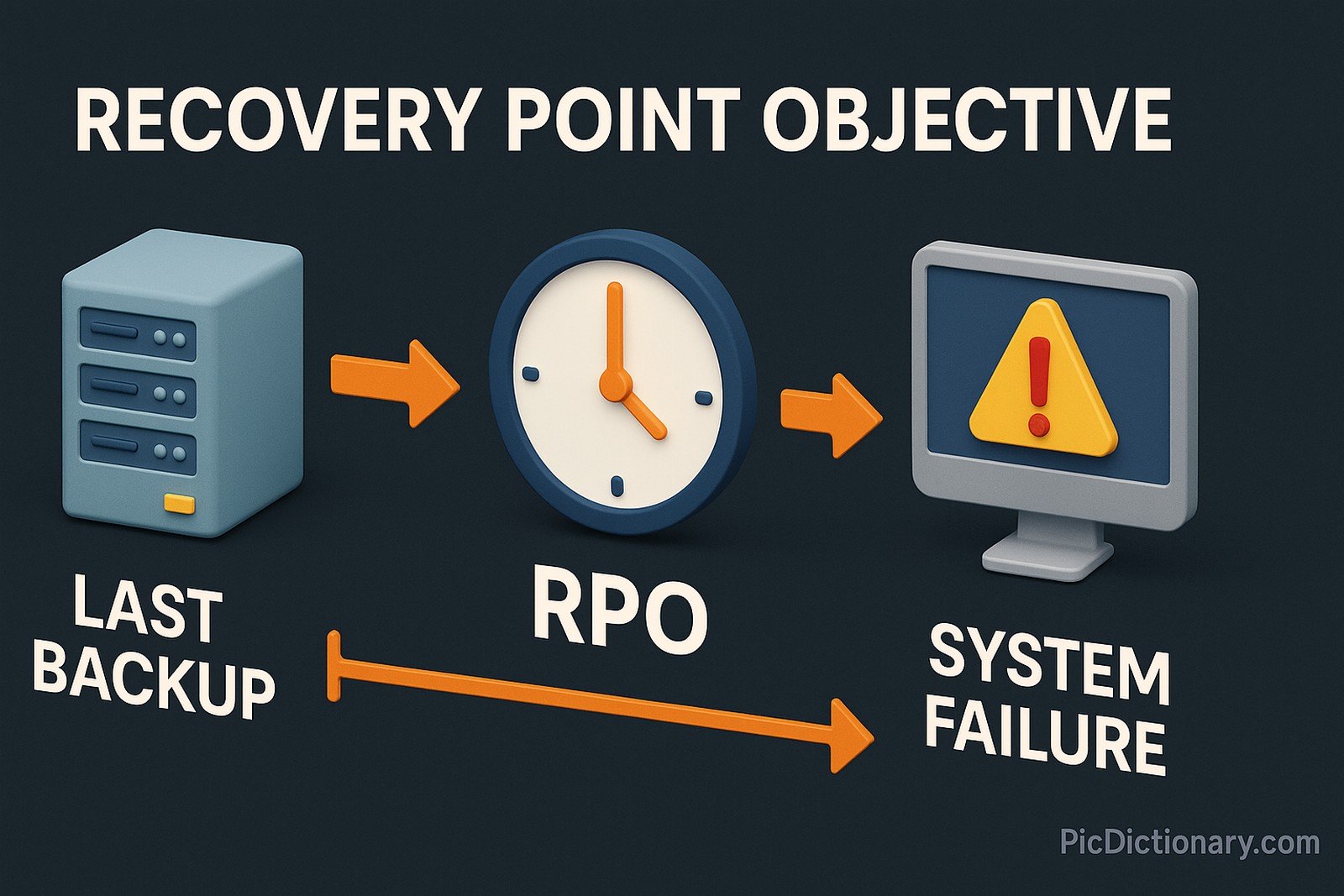Recovery Point Objective (RPO)

Quick Navigation:
- Recovery Point Objective (RPO) Definition
- Recovery Point Objective (RPO) Explained Easy
- Recovery Point Objective (RPO) Origin
- Recovery Point Objective (RPO) Etymology
- Recovery Point Objective (RPO) Usage Trends
- Recovery Point Objective (RPO) Usage
- Recovery Point Objective (RPO) Examples in Context
- Recovery Point Objective (RPO) FAQ
- Recovery Point Objective (RPO) Related Words
Recovery Point Objective (RPO) Definition
Recovery Point Objective (RPO) is the maximum tolerable amount of data loss measured in time. In the context of backup and disaster recovery, it defines the period between the last backup and a potential failure. For example, if the RPO is 4 hours, a company can afford to lose up to 4 hours of data. RPO is a critical metric for designing backup strategies, ensuring business continuity, and minimizing disruptions due to unexpected events like system crashes, cyberattacks, or natural disasters.
Recovery Point Objective (RPO) Explained Easy
Imagine you’re doing homework and you save your work every 30 minutes. If your computer crashes, the most you’ll lose is what you did in the last 30 minutes. That 30 minutes is your Recovery Point Objective. It tells you how much work you could afford to lose without causing big problems.
Recovery Point Objective (RPO) Origin
The concept of RPO comes from disaster recovery planning and IT infrastructure design. As businesses became increasingly dependent on data, defining clear RPOs became vital to align technological capabilities with business needs and risk tolerance.
Recovery Point Objective (RPO) Etymology
The term combines "recovery," referring to restoring data after a loss, "point," indicating a specific moment in time, and "objective," highlighting a goal or target threshold.
Recovery Point Objective (RPO) Usage Trends
With growing reliance on digital systems and cloud storage, RPO has become a common consideration in business continuity planning. Organizations now demand lower RPOs to ensure minimal data loss. Financial services, healthcare, and e-commerce industries emphasize strict RPOs due to regulatory requirements and customer expectations.
Recovery Point Objective (RPO) Usage
- Formal/Technical Tagging:
- Disaster Recovery
- Backup Strategy
- Business Continuity - Typical Collocations:
- "set RPO thresholds"
- "low RPO environments"
- "defining RPO and RTO"
- "RPO calculation"
Recovery Point Objective (RPO) Examples in Context
- A financial institution sets an RPO of one hour to minimize transactional data loss.
- Cloud providers offer services with customizable RPO to meet client-specific requirements.
- Hospitals require very low RPOs to ensure that patient data is always up-to-date.
Recovery Point Objective (RPO) FAQ
- What is Recovery Point Objective (RPO)?
It is the maximum acceptable amount of data loss measured in time, used for planning backup and recovery. - How is RPO different from RTO?
RPO measures data loss tolerance in time, while RTO (Recovery Time Objective) measures the duration required to restore systems after failure. - Why is RPO important?
It helps organizations set backup frequency and ensure minimal disruption during data loss events. - Can RPO be zero?
Yes, but achieving zero RPO requires continuous data replication, which is costly and complex. - How do businesses determine RPO?
By analyzing the impact of data loss on operations and balancing risk with cost and feasibility. - Which industries need the strictest RPOs?
Banking, healthcare, and online retail often require near-zero RPOs. - Is RPO the same for all data?
No, different types of data can have different RPOs depending on their criticality. - How does RPO affect backup frequency?
Lower RPOs demand more frequent backups or continuous replication. - Can RPO change over time?
Yes, businesses periodically reassess RPOs as systems evolve and risks change. - What tools help in achieving RPO?
Backup software, cloud storage, and continuous data protection (CDP) solutions help meet defined RPOs.

Recovery Point Objective (RPO) Related Words
- Categories/Topics:
- Disaster Recovery
- Data Backup
- Business Continuity
Did you know?
In 2017, Amazon Web Services experienced an outage that affected thousands of businesses. Many companies with well-defined RPOs were able to recover quickly, demonstrating the critical role of RPO planning in minimizing the impact of large-scale service disruptions.
PicDictionary.com is an online dictionary in pictures. If you have questions or suggestions, please reach out to us on WhatsApp or Twitter.Authors | Arjun Vishnu | @ArjunAndVishnu

I am Vishnu. I like AI, Linux, Single Board Computers, and Cloud Computing. I create the web & video content, and I also write for popular websites.
My younger brother, Arjun handles image & video editing. Together, we run a YouTube Channel that's focused on reviewing gadgets and explaining technology.



Comments powered by CComment